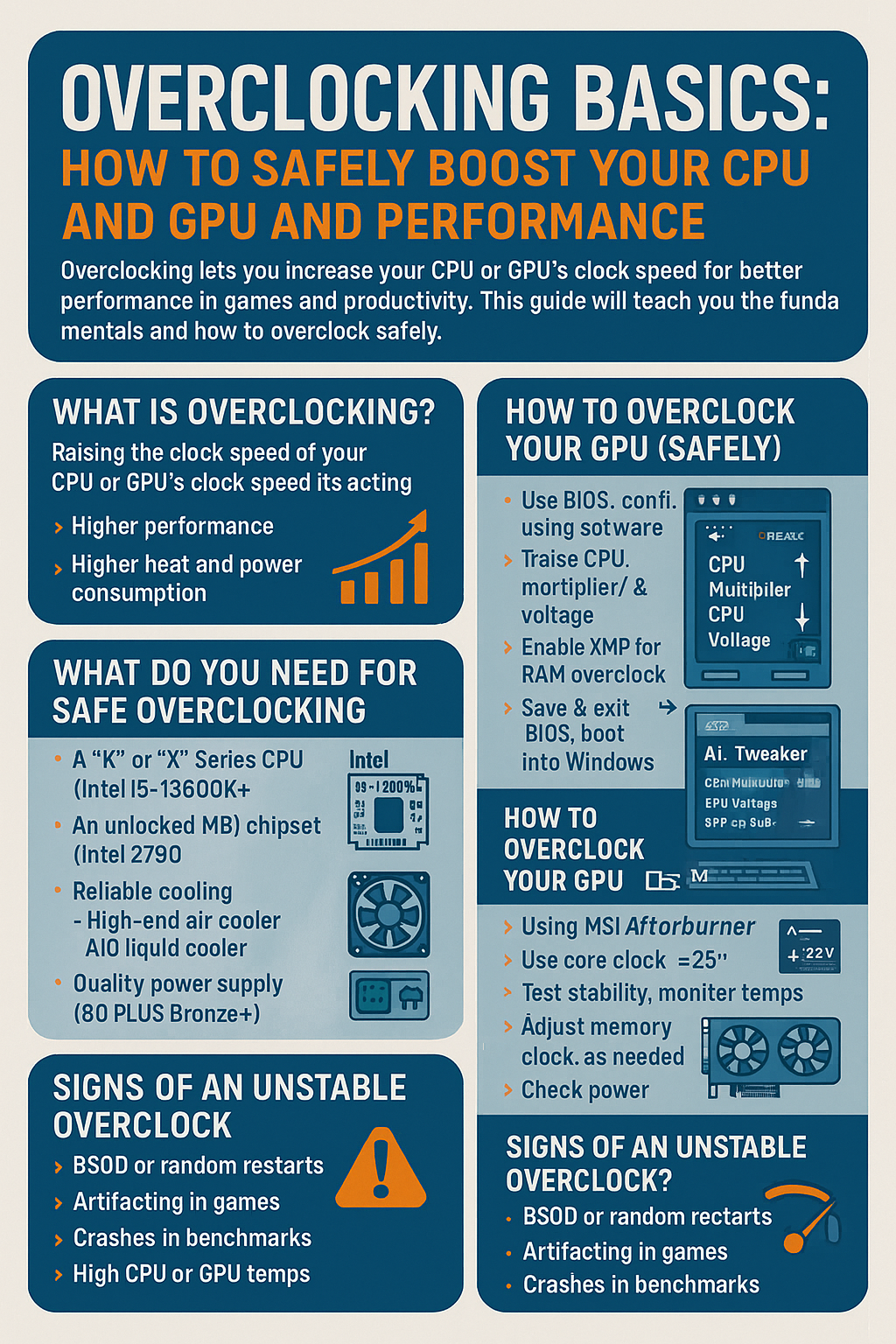Overclocking has long been a way for PC enthusiasts to squeeze extra performance from their hardware — but in 2025, is it still worth it? And more importantly, how do you do it safely?
This guide will explain the fundamentals of overclocking for CPUs and GPUs, show you what tools to use, and help you get extra speed without risking your system.
What Is Overclocking?
Overclocking means increasing the clock speed of your CPU or GPU beyond its factory-set specifications. This can deliver better performance in games, rendering, and multitasking.
However, higher speeds mean more heat and power consumption, so you’ll need proper cooling and a quality power supply.
Is Overclocking Safe in 2025?
Yes — if done carefully.
✅ Modern CPUs and GPUs have thermal protection
✅ BIOS and driver software include limits and monitoring tools
✅ Chips are more durable and adaptive than ever
❌ But poor cooling or excessive voltage can cause damage over time
Goal: Achieve stable performance gains without overheating or crashing.
What Do You Need for Safe Overclocking?
🔹 1. A “K” or “X” Series CPU
- Intel: i5-13600K, i7-14700K, etc.
- AMD: Ryzen 5 7600X, 7800X3D, etc.
🔹 2. Unlocked Motherboard Chipset
- Intel Z790, Z690
- AMD B650, X670
🔹 3. Reliable Cooling
- High-end air cooler or AIO liquid cooler
- CPU temps should stay under 85–90°C under full load
🔹 4. Quality Power Supply
- 80 PLUS Bronze (or higher)
- Clean and stable voltage matters!
How to Overclock Your CPU (Safely)
✅ BIOS Method (Recommended)
- Enter BIOS by pressing DEL/F2 during boot
- Go to “Tweaker” or “AI Tweaker” tab
- Set CPU multiplier (e.g., from 40x to 45x)
- Adjust core voltage if necessary (start low!)
- Enable XMP/EXPO for RAM overclock
- Save and exit → boot into Windows
🔍 Testing Stability
Use stress tests:
- Cinebench R23
- OCCT
- Prime95 (Blend or Small FFT)
- Monitor temps with HWMonitor or HWiNFO
Stable = no crashes for 15–30 minutes under load
How to Overclock Your GPU
Use software provided by GPU manufacturers:
🔧 Tools:
- MSI Afterburner (NVIDIA/AMD)
- AMD Radeon Software
- EVGA Precision X1
Steps:
- Increase core clock in small steps (+25 MHz)
- Test stability with 3DMark, Unigine Heaven, or games
- Monitor temps (keep below 85°C)
- Then adjust memory clock (+50–100 MHz)
- Increase power limit and fan curve if needed
Signs of an Unstable Overclock
❌ BSOD (Blue screen of death)
❌ Random restarts
❌ Artifacting (visual glitches) in games
❌ Crashes during benchmarks
❌ CPU or GPU temperatures exceeding 90°C
If any of these happen:
- Lower the multiplier or clock speed
- Reset BIOS to default (Clear CMOS)
- Reduce voltage slightly
Undervolting: The Safer Alternative?
Undervolting means reducing voltage while keeping stock clock speeds or mild overclocks.
✅ Runs cooler
✅ Increases lifespan
✅ Lowers fan noise
✅ Maintains performance
Tools:
- Intel XTU (for Intel CPUs)
- Curve Optimizer (for Ryzen CPUs)
- MSI Afterburner / Radeon Software (for GPUs)
Should You Overclock in 2025?
It depends on your goals:
| Use Case | Overclocking Value |
|---|---|
| Gaming | Moderate (up to 10% FPS gains) |
| Video editing/rendering | Significant performance increase |
| Casual use/browsing | Not needed |
| Laptop use | Not recommended |
| Quiet PC builds | Not ideal (more heat/noise) |
Safety Tips
✅ Monitor temps constantly during testing
✅ Use quality thermal paste and good airflow
✅ Don’t chase extreme voltages for tiny gains
✅ Backup BIOS profiles before applying big changes
Final Thoughts
Overclocking in 2025 is safer and easier than ever — but requires patience and knowledge. With the right hardware and software, you can safely boost performance in games and productivity without pushing your PC over the edge.
Start small, monitor everything, and enjoy the free performance!
